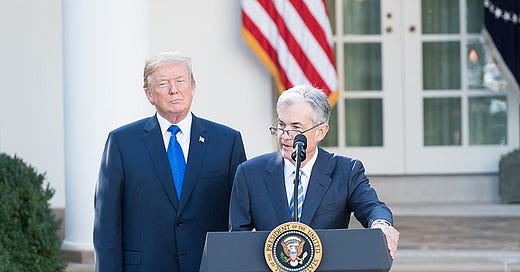Smart Money Doesn’t React. It Prepares.
Volatile markets move fast. Most people are left reacting, but the strategic ones have already built a plan. No guesswork required.
With BELAY, you get an expert Accounting Professional who can help you decide what matters and act on it before it costs you. From preserving cash to uncovering inefficiencies to reinvesting with precision, a BELAY Accounting Professional will help you stay ahead of this turbulent market.
Want the guide their top clients use during times of uncertainty?
Grab BELAY’s Financial Forecasting Guide: Predicting & Planning for the Future. No strings. Just clarity.
In the middle of a 90-day tariff pause, record-high economic uncertainty, and the increasing likelihood of an upcoming recession, the Federal Reserve once again decided to pause interest rate cuts – despite public threats from Donald Trump to fire Jerome Powell.
In just the last few weeks, we’ve seen chaos over rising tariffs, pushback from China, and increasing prices on everyday products. Somewhat contrary to expectations, we could also be seeing the potential start of a brand new bull market in what’s being called “The Global Reset.”
So in today’s issue, we’re going to unpack everything that’s happening – when interest rates could potentially come back, what Jerome Powell and Trump had to say about it, how this affects you, and what you can do to protect your investment.
Can the president fire the Fed chair?
Let’s start with the question on everyone’s mind: can Donald Trump actually fire Jerome Powell, the Chair of the Federal Reserve?
First, let’s get this straight: despite its name, the Federal Reserve Bank isn’t really a “bank.” It doesn’t hold accounts or reserves like commercial banks do. It’s also designed to operate independently from the federal government, and its main responsibility is to guide interest rates and maintain economic stability. It does this by influencing inflation and unemployment rates. The Fed’s decisions affect savings accounts, borrowing costs, and mortgage rates – which also ends up affecting the stock market and the real estate market (more on this later).
A few weeks ago, Fed Chair Jerome Powell made it clear: they’re holding off on rate cuts because of the inflationary risks posed by tariffs. His position is that it’s better to move slowly and wait until inflation is fully under control, rather than risk cutting too soon and sending prices soaring again.
Trump doesn’t agree. He’s said publicly, “Powell’s termination cannot come fast enough,” called him as a “major loser.” According to Trump, inflation is no longer a concern, and the real danger is a slowing economy. He later softened his remarks, but the message was clear: he wants lower rates and is frustrated that the Fed won’t concede.
But can he actually fire Powell? Technically, no. At least not yet. Powell has said himself, “We’re not removable, except for cause.” A sitting president can’t remove the Fed Chair just because they disagree on policy – but this may be on shaky ground. A recent Supreme Court ruling gave the president more authority to remove board members from independent federal agencies (The Guardian, AP News). The precedent is evolving, and although it’s still unlikely, there’s now a legal window through which a future administration might try to push Powell out.
Why does this matter?
If a president could remove the Fed Chair over policy disagreements, it would erode the independence of the entire central bank. Economists think this would destroy trust in the Fed and make markets more volatile, because investors want interest rates to be based on data rather than political threats.
Powell’s job is safe for now, and the Fed’s independence remains intact. But this power struggle is unfolding just as another major pressure point returns to the spotlight: tariffs.
The Tariff Pause – and signs of hope
On April 9, Trump issued a 90-day tariff pause that reduced import tariffs to just 10%. The goal was to give other countries time to strike new trade deals before the original, higher tariffs would automatically resume on July 8. So far, though, there haven’t been any confirmed breakthroughs.
But China – the biggest trading rival, wasn’t even offered a pause. After the U.S. imposed a 145% tariff on Chinese goods, China hit back with a 125% tariff on American imports. Also, a loophole that had allowed low-cost goods to enter the U.S. tariff-free if they were under $800 in value has now been closed. Now, those same items could cost as much as $24.50, with the added costs passed straight to the consumer.
But things could be changing for the better. A supposed trade deal between the US and China after negotiations in Geneva yesterday could remove tariffs on both sides. Investors are cheering again as markets and supply chains are showing hopes of reviving. China has already waived off some tariff exemptions on imports of ethane and some other key goods – which means that the trade war might be de-escalating.
Meanwhile, we have a more immediate fear creeping in…
Recession Fears
According to a recent CNN poll, market anxiety is nearing record highs.
66% of adults are pessimistic or afraid of the economy, and 69% believe a recession is at least somewhat likely within the next year. It might be tempting to dismiss this as overreaction, but early data is backing this possibility. BlackRock’s CEO recently stated that many business leaders believe the U.S. economy is already in a recession.
Apart from investor sentiment, supply chain delays are getting worrying. Shipping times between the U.S. and China can take a month: One economist warned that container ships are expected to stop arriving at U.S. ports by mid-to-late May. That’s followed by layoffs in trucking and retail sectors, and by summer, the full impact could hit.
As for GDP numbers, first quarter growth was flat, which puts us halfway toward meeting the technical definition of a recession.
Some critics point out that many companies pre-ordered inventory to buffer against potential disruptions. Others believe the economy needs a “detox period.” But sometimes, economic fear can be self-fulfilling. When people anticipate a downturn, they cut back on spending and that slowdown in demand can tip the economy exactly where they feared it would go.
Despite this uncertainty, markets are still rallying – which brings us to a surprising technical signal that’s grabbing investor attention.
Markets Are Rallying, but…
Even with all the economic uncertainty, the stock market has been climbing. After some of the worst single-day point losses in history, prices have nearly recovered and have risen steadily for over a week. While volatility certainly isn’t over, there’s one technical signal that has investors wondering if we’re on the edge of a new bull market: the Breadth Thrust Indicator.
This indicator tracks sharp surges in market participation, when a large number of stocks all rise together. Since 1945, it’s correctly signaled the start of a bull market 14 out of 14 times, with average gains of 24.6% over the following 11 months. Now, that signal has been triggered again. If history repeats, this could mark the beginning of another strong run in equities. A trade deal with China or a drop in interest rates could be enough to send us back to all-time highs, according to analysts. Considering that we just made a trade deal with China, we’ll have to see where this goes.
But it’s worth remembering that every market is different, and the world we’re in now isn’t the same as it was in any of those past 14 occasions. We’re dealing with tariff threats, a hawkish Federal Reserve, and weakening consumer sentiment. One offhand comment or surprise headline could easily spook investors and tank the momentum.
While the stock market is hopeful, housing is sending more mixed signals.
What About Housing?
Nationally, home prices were up 3.9% year-over-year in February. But that growth is slowing. Month-over-month, prices barely moved, rising just 0.1%. Some markets are still hot. New York saw a 7.7% annual gain, Chicago came in at 7%, and Cleveland posted 6.6%. But in cities like Tampa, prices have actually declined 1.5%.
While the overall market appears stable, buyer sentiment is cautious. According to Zillow, median home prices could turn negative later this year, falling 1.9%. If that happens, it would be the first nationwide decline since the Great Financial Crisis. Their reasoning: Rising inventory and high mortgage rates are leading to buyers holding out for better deals. Meanwhile, sellers are starting to cut prices to attract offers.
This isn’t a crash scenario but it does reflect a shift in psychology. People are tightening spending, saving more, and putting off big purchases like homes. In the short term, this could weigh on the market. On the other hand, if inflation cools and rates eventually fall, the sidelined cash could come back into the housing market.
So both stocks and housing are sending us signals. But it all depends on what the Federal Reserve plans to do next…
Powell’s Message: Not Yet
Jerome Powell has made it clear once again: the Fed is not cutting interest rates yet. Any future cuts will be based entirely on data, only if inflation is firmly under control.
Tariffs are inflationary, according to him, and right now, it’s too early to tell how this will unfold. The Fed doesn’t want to cut rates prematurely, see inflation bounce back and reverse course later. Powell also pointed to the strength of the labor market as a reason to hold steady. With unemployment still low and job growth solid, he believes the economy doesn’t need to be “rescued” just yet.
When might rate cuts happen? Powell didn’t give an exact timeline, but some projections suggest July or September at the earliest, if the data supports it. Realistically, anything could change between now and then. New data, new geopolitical developments, or market shifts could all alter the Fed’s course.
What I'm Doing
Personally, I don’t think the Federal Reserve will lower interest rates as quickly as many expect. But then again—stranger things have happened. Even though around 90% of Americans believe tariffs are inflationary, some economists argue that the worst of the price hikes might be behind us. If that’s true, there’s a case to be made for lowering rates even with tariffs in place, without reigniting inflation.
Honestly, though? This is way above my pay grade. I’m just a finance aficionado trying to make sense of everything that’s going on in the market. I don’t pretend to know what’s coming next. That’s why I don’t try to time any of this. My approach is simple: I buy regularly, dollar-cost averaging no matter what the market’s doing. I invest in U.S. stocks, international stocks, and a little bit into a Bitcoin ETF. If prices drop, great, I buy in at a discount. If they rise, even better because I’m already invested and get to ride the gains.
It’s not flashy, but it works for me. I’m not betting on headlines or guessing what Powell or China will do next. I’m just staying consistent, staying invested, and sticking to a plan.
And that’s what I’ll keep doing while continuing to bring you updates along the way. If you want to stay in the loop, feel free to subscribe and drop a comment. I always read every single comment and reply. Thank you for reading!
And don’t forget to check out today’s sponsor Belay.





I appreciate you adding the last section about what you are doing during this time. I'm always curious.
Great article. Thank you.